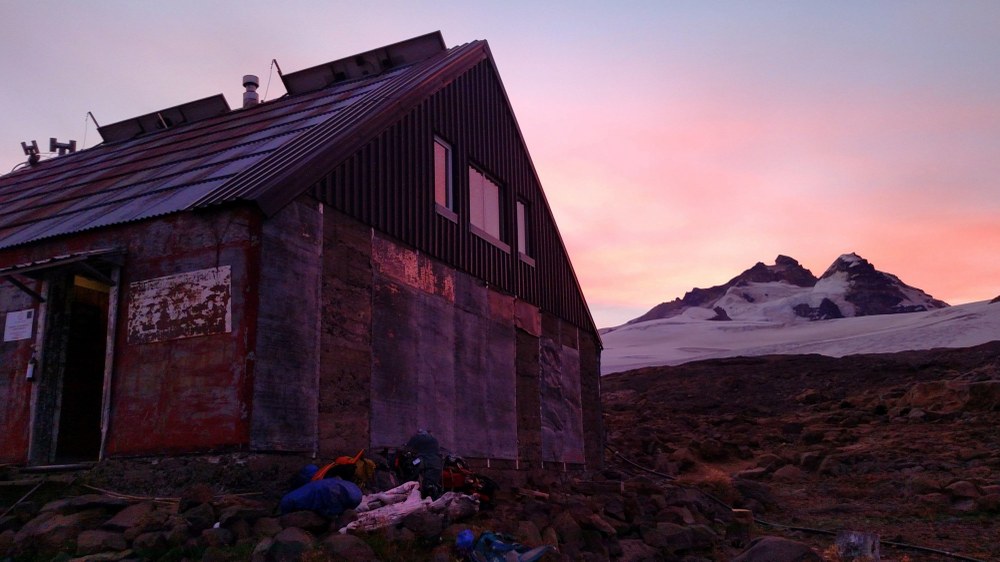
The last brilliant fuchsia tones faded away from the slopes of Cerro Tronador as we looked across the deep chasm of the Rio Alerce. We were perched on the porch of the Otto Meiling Hut, and the 3,470m mountain (translated to “The Thunderer”) was the seventh stop on our nine-day trek.
Our Mountaineers Global Adventures group was traversing the northern Patagonian Andes, beginning in Bariloche, Argentina. Backpacking across the granite balds and craggy crystalline peaks of Nahuel Huapi National Park, the largest and oldest national park in Argentina, in two days’ time we would be connecting to a ferry along a string of enormous montane lakes that would carry us nearly all the way to the west coast of Chile. While most international trekkers think of the far south and Torres del Paine when they hear mention of Patagonia, many guides and hardy backpackers have told me that their favorite spots in the region are in this northern Patagonian park, part of the aptly-named Lakes Districts of Argentina and Chile. So far our route had brought us wild and lonely lakeside camps, high ridge traverses, 360-degree views of lakes and peaks, stays at a few of the park’s cozy huts that offered food, libations, and comfy communal bunk rooms, and camaraderie with other intrepid explorers.
At the Meiling Hut we were treated to the tradition of sharing yerba mate, a somewhat bitter, grassy tasting leaf said to have pre-Colombian origins. The tradition, deeply anchored in Argentine culture, is a communal activity in which the participants sit in a circle and one person, the server or cebador, prepares the drink by packing mate leaves into a gourd and adding hot water, passing the vessel around the circle to the right. One finds out quickly that you never move the bombilla, you take your sip efficiently and don’t hog the gourd, and perish the thought that you might misunderstand and walk away with the gourd thinking that it was made just for you! We found the mate ceremony everywhere we went in Patagonia, among young and old, the grizzled greybeards and the dreadlocked backpackers, in the high huts and on the posh streets of Buenos Aires. To be invited to participate in the mate tradition (and to feel enough mastery to avoid a serious mate faux pas) is to feel that you belong here.
Upon leaving Cerro Tronador we crossed a flat glacier, descended a cirque gushing with waterfalls, and crossed a knife-edge ridge to our last night’s hut, Refugio Agostino Rocca. After our stay we steeply descended along Rio Frias through the ancient moss-draped forests of Alerce (also called Patagonian Cypress, which can grow to be some of the oldest and largest trees on earth), before arriving at Lago Frias. From there, some in our group took a ferry-bus combo across two lakes to return to Bariloche, and others chose to carry on into Chile to hike its volcanoes, explore a granite canyon, and enjoy great wine and seafood. On our ferryboat we passed perfectly conical volcanoes reflecting up at us from the deep blue lakes. Nestled in the mountains and crystalline waters of what felt like paradise, we couldn’t help but wonder what the next day would hold.
Lead image of a sunset over Cerro Tronador from the Otto Meiling Hut. Photo by Cheryl Talbert.
Join Cheryl Talbert as she brings our Global Adventures program back to Patagonia on two back-to-back trips held in February and March of 2022. You will be backpacking and hut-hopping from Bariloche to Tronador in Argentina before completing your Andes crossing, then day hiking among some of the loveliest lakes, volcanoes, and hot springs of Chilean Patagonia! Learn more at mountaineers.org/globaladventures.
This article originally appeared in our Summer 2021 issue of Mountaineer Magazine. To view the original article in magazine form and read more stories from our publication, visit our magazine archive.
 Cheryl Talbert
Cheryl Talbert